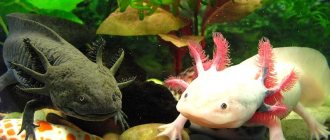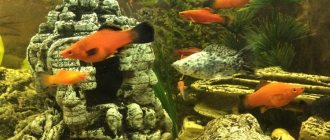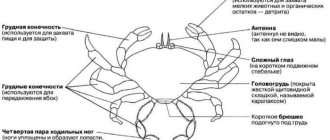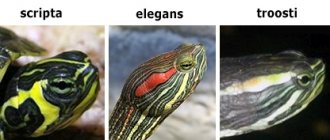- Wild animals
- >>
- Fish
Dragon fish is a rare and dangerous species. Found in the Black, Mediterranean and Atlantic seas. The genus has several species, among which there are both perch-like and those similar to seahorses. The fish differ significantly from each other and in appearance. The main feature is that the Great Sea Dragon is a poisonous fish that poses a danger to both fishermen and tourists. that is why it is important to know its main differences and lifestyle.
Origin of the species and description
Photo: Dragon fish
The large sea dragon is a ray-finned fish (percid). But the small one (deciduous, rag-eater) is a subspecies of needle fish and belongs to seahorses. Almost everything differs between these two large subcategories of draconian representatives: from appearance to lifestyle features. Although there is also a common feature - all these fish are predators.
Video: Dragon fish
In total, there are 9 main species among dragons. The most interesting thing is that even in the modern world, this list is replenished with new species. The body length of the fish varies from 15 to 55 cm. It all depends on what type of dragon it is.
Fish are predominantly nocturnal. Large dragons are distinguished by the fact that they are classified as poisonous fish. The glands themselves are absent on the body and the poison is found only on the thorns. It is not believed to be fatal to humans. But it can provoke severe allergic reactions and disturbances in the functioning of the heart.
Many sources provide information that these are one of the very first fish to appear on our planet. By the way, it is interesting that small dragons are among the most beautiful fish that exist in nature, while a large dragon is often frightening with its appearance, although to some it resembles the most ordinary bull.
Scientific classification
According to scientific nomenclature, the axolotl occupies the following place in the taxonomy:
- Domain: Eukaryotes.
- Kingdom: Animals.
- Subkingdom: Eumetazoa.
- Type: Chordata.
- Class: Amphibians.
- Order: Tailed amphibians.
- Family: Ambystomaceae.
- Genus: Ambystoma.
- Species: Axolotl.
Photo: Axolotl
Appearance and features
Photo: What does a dragon fish look like?
The grass dragon is considered the largest among the representatives of the genus - it can reach half a meter in length. It is also considered the largest among the seahorse subtypes. The main distinguishing feature is the fancy decoration of the body.
The leafy seadragon is in many ways similar to the classic seahorse, while the ragdragon has a less remarkable coloration. Because of this, when it drifts in the water column, it is often confused with ordinary algae. A thin snout, a flattened head and an elongated body are what make the small sea dragon stand out from the crowd.
Throughout the body there are bizarre outgrowths that have a thin base and gradually expand like blades. They are intended solely to protect the fish from enemies, because otherwise they have no chance - the movement speed of small sea dragons does not exceed 150 m/hour.
The color of the small dragon is very diverse. Yellow and pink predominate here, with pearl dots on top. Narrow blue stripes arranged vertically adorn the front of the fish's body.
The big dragon is not so attractive in appearance, but no less remarkable. On its head you can see a black crown with spikes, and in the area of the gill arches there are games. The head of this fish is large with a massive jaw, which is studded with small teeth. There is a long mustache on the lower jaw. It is also noted that the dragon fish has very large and expressive eyes. Despite such aggressive behavior, the size of the fish is not too impressive - the body length reaches only 15-17 cm.
Interesting fact: The grass sea dragon has a mass of processes throughout its body that make it stand out from the crowd and make it look more like a fairy-tale creature than a fish. In fact, these processes do not actually perform any tasks - they are intended only for camouflage.
Where does the dragon fish live?
Photo: Sea dragon fish
Habitat and water preferences directly depend on what species of sea dragon is being considered. Deciduous and grass dragonets, which are relatives of seahorses, prefer the waters of South and Western Australia. The most comfortable water for their habitat is moderate temperature water closer to the shore.
The great sea dragon is a much more common species in nature. It is found almost all over the world. The exceptions are the North and South Poles. The dragon's most favorite habitat is sandy areas. That is why Bulgaria is simply an ideal habitat for them. The dragon can feel great both in deep water and near the shore.
You can also meet this type of sea dragon in the Black Sea. But sea dragons are most common in the tropics. There they can be found at a depth of up to 1.5 km. If the fish makes trips to the deepest water areas, then only short ones. The reason is that they need to hunt, and this can only be done in areas where they can hide and wait for prey.
For dragon fish, this can only be done by burying itself in the sandy bottom. Conclusion: the dragon simply needs to stay as close to the bottom as possible. Moreover, this can only be done in those areas where a large concentration of potential prey also lives near the bottom. The dragon is exclusively a marine fish and therefore does not enter river mouths, so there is definitely nothing to fear there.
By the way, in seas with too high levels of salt in the water, the slave also feels uncomfortable. The sea with moderate salinity and fairly warm water is considered the most favorable for fish. At the same time, the dragon can adapt to harsh climates. For example, in the Black Sea, the water can be quite cold in winter - this does not prevent a large dragon from feeling quite normal there.
Now you know where the dragon fish is found. Let's see what she eats.
Keeping in an aquarium
Keeping an axolotl at home requires careful attention from the owner and setting up an aquarium for the axolotl. Ideally, each amphibian should be provided with a separate tank with a capacity of 50 liters or more, but you can also put a couple of dragons in one container. If two dragons live in the same artificial pond, both pets should be the same size - this will help avoid cannibalism and injury. Accordingly, when two water dragons are introduced, the size of the aquarium increases.
What does dragon fish eat?
Photo: Dragon fish in the Black Sea
Regardless of species, sea dragons are all predators, so they feed on other sea life. Crustaceans and small fish are the main prey of sea dragons. At the same time, a large dragon leads a more active lifestyle, so it is always easier for it to get food. Since catching fish can sometimes be difficult, crustaceans still form the basis of the diet of a large sea dragon. But, unlike its herbal counterpart, it practically does not eat plant foods.
The small sea dragon has no teeth and therefore simply swallows its prey. Most often, this fish prefers shrimp, swallowing up to 3 thousand per day. He can also feast on small fish, simply sucking on the food. In shallow water, the small dragon may also consume algae or collect food scraps on the shore.
Interesting fact: Sea dragon venom has been known to cause deaths. In this case, the cause of death is the development of heart failure. Pain shock is also dangerous.
Since dragons live in warm waters, there are usually no seasonal restrictions in terms of diet. But for the inhabitants of cold waters, nature has provided for seasonal migration to warmer waters. By the way, although a large dragon is much faster than a small one, it prefers to practically not pursue prey, but to take a wait-and-see position at the bottom of the reservoir. Only in rare cases do dragons hunt in schools. They mostly prefer solitary hunting.
Feeding
Due to their high gluttony and indiscriminate eating habits, Polypterus are often called Siamese catfish and sea sharks.
You can feed them live, frozen, dry ready-made food. Suitable:
- bloodworm;
- tubifex;
- finely chopped veal;
- beef heart;
- sea and live river fish;
- dry mixtures for predators in limited quantities.
The main requirement for the diet is a high protein content. In addition, polyfins cannot eat from the surface of the water; pieces of food must necessarily sink to the bottom.
Pangasius will not eat even in high light conditions; they need twilight.
If the multifeathers have reached an advanced age (7-10 years), then their sharp teeth wear down and then it’s time for plant food:
- finely chopped lettuce, spinach, dandelion leaves;
- pieces of zucchini;
- grated cucumbers;
- porridge;
- boiled mashed potatoes.
Features of character and lifestyle
Photo: Dragon fish in the sea
The lifestyle and behavior of sea dragons differs depending on which species is considered. All fish of this genus are predators, but there are still some special differences in behavior. For example, the main difference is the hunting of other representatives of the deep sea. The large dragon spends most of its time searching for prey, sitting in ambush and waiting for its next victim.
At the same time, the small sea dragon is absolutely harmless and does not pose any threat to humans and many other fish. Although he is also a predator, he still does not hunt so actively. This is primarily due to the fact that plant foods may well be included in the diet. Large dragons prefer to lead a solitary lifestyle, while small ones gather in flocks.
These species have one thing in common - the desire to hide as much as possible. If large dragons prefer to bury themselves in the sand, then small ones simply hide in the algae. Grass dragons can blend in so skillfully that they go undetected for a long time. When a dragon hunts, most often it simply buries itself in sand or mud. There he can only wait for his victim.
Unfortunately, because of this, the dragon can be dangerous not only for other marine life, but especially for humans. Even after seeing a sea dragon, it is not difficult to confuse it with a simple goby. But most often the dragon is simply not noticed in the water. This threatens that you can simply step on it, in response to which the fish bites and injects poison.
Social structure and reproduction
Photo: Black Sea dragon fish
Lesser sea dragons are simply amazing parents. They take care of their babies for a very long time. In this case, males take the most active part in this. Unlike their cousins (pipits), small dragons do not have a pouch in which they can safely carry eggs. Here nature has provided a more complex system: fertilized eggs are securely secured under the male’s tail using a special liquid.
The female first lays approximately 120 bright red eggs, which are then fertilized. After consolidation, their pairs actively communicate with each other, arranging mating dances, during which the fish get closer to each other and change color to a brighter one. When about 6-8 weeks have passed, the little dragons will be born.
Outwardly, they are completely similar to their parents and there are no serious differences. Then they can live completely independently and reach puberty by 2 years. In rare cases (about 5%), fish continue to live with their parents.
The large sea dragon prefers to breed exclusively in shallow water. During the period May-November, the fish move closer to the shore to spawn. At the same time, how close to the shore you approach directly depends on the species of the fish. For example, the Black Sea dragon at this time does not come closer to those areas where the depth is 20 m. The large dragon lays its eggs in the sand. Subsequently, fry will appear from them.
Breeding
Sexual differences between male and female polygons are subtle and only a specialist can understand them. Males have a wide, spade-shaped anal fin and a medium-sized head, while the female has a narrow and pointed rear plumage, and the upper part is more massive.
For spawning and artificial propagation of polypterus, special conditions must be created, and the aquarist must have sufficient experience.
The following can be considered as stimulating factors simulating the natural rainy season:
- slight softening and acidification of the aquatic environment;
- increase in water temperature by a couple of degrees.
If spawning occurs, then the most likely time is July-October.
The established pair swims side by side, touching their bodies, biting each other’s fins.
Surprisingly, the female lays eggs only in the “hands” of the male. The male folds his pectoral fins in a certain way so that it looks like a bowl, and takes valuable cargo into it. Then it independently and evenly distributes the eggs on the surface of aquatic plants.
If the owner wants to preserve the offspring of polyptersus, then the adult individuals now need to be removed.
After 5-7 days, the eggs hatch into fry. They are aggressive from the first days of life and in order to prevent cannibalism, they must be periodically sorted by size and seated.
In order for small multi-feathers to develop well, the water must be diluted very often with fresh portions and aeration must be increased.
The fry begin to be fed a week after hatching. The first food is usually Artemia naupelia. When the body size of the multifeathers reaches 5-6 cm, they are transferred to adult feeding.
Natural enemies of dragon fish
Photo: Poisonous dragon fish
In nature, the enemies of sea dragons are large predatory fish. Moreover, it is actually much easier for a large dragon to protect itself, thanks to the thorn and poison. Sperm whales and other large fish most often attack dragons, simply swallowing them along with other fish.
Occasionally, dragons can become prey for animals that come close to the seashore. If you catch and then eat fish correctly, you can easily enjoy it by simply taking it out of the sandy bottom.
Interesting fact: One of the main enemies of the sea dragon is man. Despite the fact that the fish is poisonous, its meat is very tasty. Therefore, if you cut the fish correctly, you can enjoy it without harm to your health.
Small sea dragons (relatives of pipits) are most susceptible to this danger. Often people can even unwittingly injure a fish when trying to pet it or even pull it out of the water to examine it in more detail. This is why catching fish is severely punished under Australian law.
Other inhabitants of the deep sea are dangerous for them for the reason that dragons swim very poorly and slowly. Also, unlike a large dragon, they are not poisonous and do not have any weapons that can somehow protect them from the attacks of other fish or humans. Only one thing can save a dragon from predatory fish - its specific color, which makes it easy to hide and become inconspicuous.
Interesting Facts
- The appearance of the relict polyfeather is very attractive, which is why it is often shown in aquariums and aquarium halls.
- Polypterus become attached to their breadwinner and, when he appears, they come out of hiding. Animals love to eat food directly from their owner's hands.
- A fish can live without water for a long time, provided that the surface of its body is constantly moistened.
- Underwater scientific videos are often filmed in the habitats of the aquarium dragon; its behavior in nature is very interesting to observe.
- In the last century, photographs of dragon fish were worth a lot of money.
Polypterus become attached to their provider
Population and species status
Photo: What does a dragon fish look like?
It is very difficult to clearly estimate the population of sea dragons. About large dragons, we can say that there are a lot of them. In addition, the number increases significantly every year. But the same cannot be said about small ones. Their population is gradually declining.
It is not possible to clearly estimate their number due to the high level of secrecy. For example, many divers complain that in 20-30 years they have never been able to see a small sea dragon, which is why they are starting to consider it just a legend.
Also, some species have only recently been discovered and are practically not studied. It should also be taken into account that various types of sea dragons inhabit the entire waters of the World Ocean, so it is not possible to count them even very roughly. That is, in relation to the great sea dragon, the status of a species for which there is no concern is quite applicable. But the small dragon is under threat of extinction.
A number of reasons can be summarized for this:
- unfavorable living conditions;
- excessive popularity among people;
- lack of any protection from predators other than secrecy;
- slowness.
That is why catching small sea dragons is prohibited; in addition, they are actively protected at the state level.
Axolotl conservation
Due to the fact that the axolotl is considered an endangered species in the world, it is listed in the Red Book. Catching these amphibians is prohibited.
But the main problem that lies in the minimal reproduction of such creatures is the insufficient number of nurseries to support them. The more people organize them, the greater the chance of increasing their population.
Limiting human exposure and comfortable aquarium conditions are two simple principles by which scientists are moving towards increasing the number of the species. Growing them in optimal natural conditions that are as natural as possible for them, the animal reproduces and is released into the lakes.
There are many bodies of water that are polluted by people, which causes irreparable harm to axolotls and other inhabitants of aquatic fauna.











